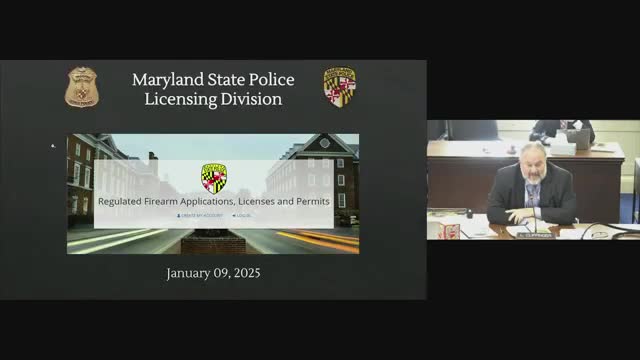State Police licensing division reports about 200,000 active wear-and-carry permits and steady application volumes
January 09, 2025 | Judiciary Committee, HOUSE OF REPRESENTATIVES, Committees, Legislative, Maryland
This article was created by AI summarizing key points discussed. AI makes mistakes, so for full details and context, please refer to the video of the full meeting. Please report any errors so we can fix them. Report an error »

Annapolis — Maryland State Police officials told the House Judiciary Committee on Jan. 9 that the Licensing Division is processing hundreds of thousands of firearm-related records and that active wear-and-carry permits have stabilized near 200,000.
Captain Andrew Rosignall, commander of the Licensing Division, told committee members the division processes three primary categories: firearms registrations (77R), applications to purchase/transfer a firearm, and the Handgun Qualification License (HQL). “We have approximately 36 sworn and 91 civilian personnel and counting,” Rosignall said, describing the division’s staffing.
Rosignall said the firearms-registration workload has remained relatively steady since 2020 at about 100,000 applications a year. The division reported roughly 200,000 active wear-and-carry permits and said that application volume spiked immediately after the U.S. Supreme Court’s Bruen decision in June 2022; by late 2023–2024, new-application volumes had dropped from that initial surge.
On renewals and processing times, Rosignall said the statutory timeframes guide decisions and that the licensing office has been meeting or exceeding those benchmarks. He gave typical processing estimates of about 50 days for original wear-and-carry applications and about 30 days for renewals, and said those figures fluctuate day to day.
Committee members asked about denial rates. Rosignall said denial reasons are typically criminal prohibitors or mental-health-related issues discovered through the division’s record checks. He did not provide a single definitive denial percentage in the briefing; he said denial rates “have remained about the same year over year” and emphasized that decisions are driven by the databases the division checks.
On out-of-state applicants, Rosignall said the requirements and prohibitions for wear-and-carry permits are the same for in-state and out-of-state applicants; the division does not apply a residency requirement for those applications. He described training and live-scan fingerprinting requirements that make very distant out-of-state applications more difficult to complete but said applications are treated the same if they meet statutory requirements.
Rosignall also described new administrative checks: daily conviction-data feeds, live-scan fingerprint notifications to the licensing division when someone is arrested in Maryland, and a record recheck process introduced Oct. 1 that runs checks at the midway point of originals and renewals to spot intervening arrests or convictions.
Members asked for additional breakdowns the division does not routinely publish in the hearing: occupation-level tallies for permit holders, how many retired law-enforcement officers hold permits, and demographic splits by race, gender and age. Rosignall said some of that data is already reported to the joint committee’s reporting process and that he would seek to provide additional detail where possible.
The committee thanked the State Police for the update and requested follow-up datasets on HQL renewals, occupational and demographic breakdowns, and state-by-state counts for out-of-state permit holders if the division can produce them.
Captain Andrew Rosignall, commander of the Licensing Division, told committee members the division processes three primary categories: firearms registrations (77R), applications to purchase/transfer a firearm, and the Handgun Qualification License (HQL). “We have approximately 36 sworn and 91 civilian personnel and counting,” Rosignall said, describing the division’s staffing.
Rosignall said the firearms-registration workload has remained relatively steady since 2020 at about 100,000 applications a year. The division reported roughly 200,000 active wear-and-carry permits and said that application volume spiked immediately after the U.S. Supreme Court’s Bruen decision in June 2022; by late 2023–2024, new-application volumes had dropped from that initial surge.
On renewals and processing times, Rosignall said the statutory timeframes guide decisions and that the licensing office has been meeting or exceeding those benchmarks. He gave typical processing estimates of about 50 days for original wear-and-carry applications and about 30 days for renewals, and said those figures fluctuate day to day.
Committee members asked about denial rates. Rosignall said denial reasons are typically criminal prohibitors or mental-health-related issues discovered through the division’s record checks. He did not provide a single definitive denial percentage in the briefing; he said denial rates “have remained about the same year over year” and emphasized that decisions are driven by the databases the division checks.
On out-of-state applicants, Rosignall said the requirements and prohibitions for wear-and-carry permits are the same for in-state and out-of-state applicants; the division does not apply a residency requirement for those applications. He described training and live-scan fingerprinting requirements that make very distant out-of-state applications more difficult to complete but said applications are treated the same if they meet statutory requirements.
Rosignall also described new administrative checks: daily conviction-data feeds, live-scan fingerprint notifications to the licensing division when someone is arrested in Maryland, and a record recheck process introduced Oct. 1 that runs checks at the midway point of originals and renewals to spot intervening arrests or convictions.
Members asked for additional breakdowns the division does not routinely publish in the hearing: occupation-level tallies for permit holders, how many retired law-enforcement officers hold permits, and demographic splits by race, gender and age. Rosignall said some of that data is already reported to the joint committee’s reporting process and that he would seek to provide additional detail where possible.
The committee thanked the State Police for the update and requested follow-up datasets on HQL renewals, occupational and demographic breakdowns, and state-by-state counts for out-of-state permit holders if the division can produce them.
View full meeting
This article is based on a recent meeting—watch the full video and explore the complete transcript for deeper insights into the discussion.
View full meeting
